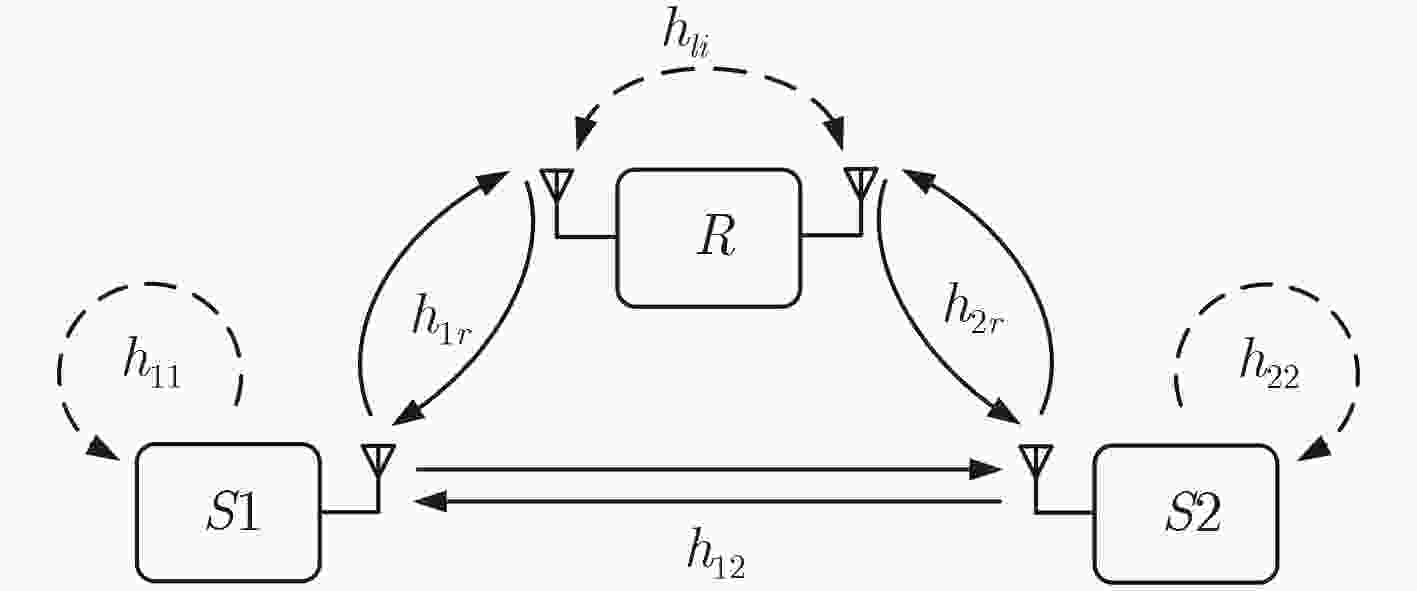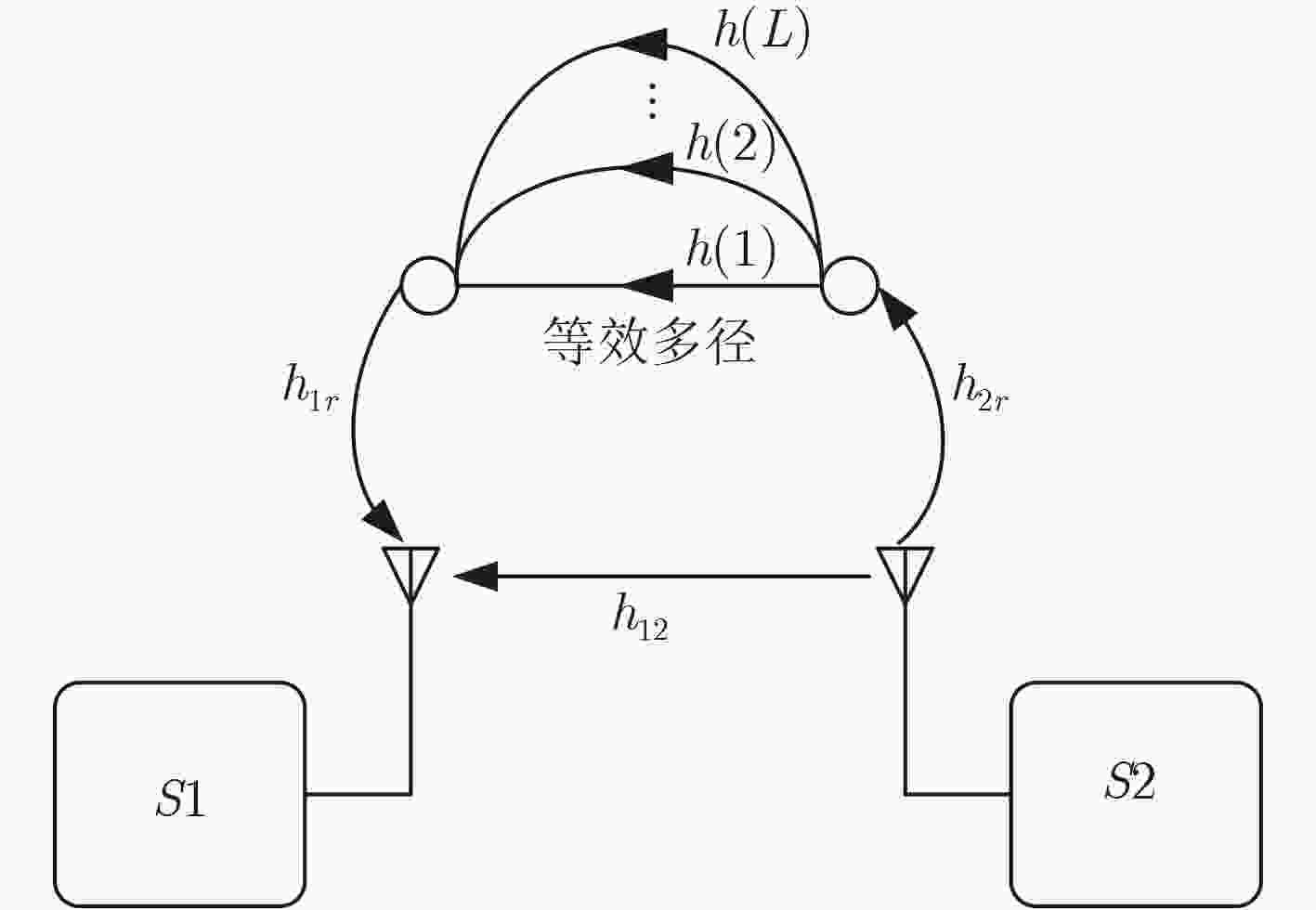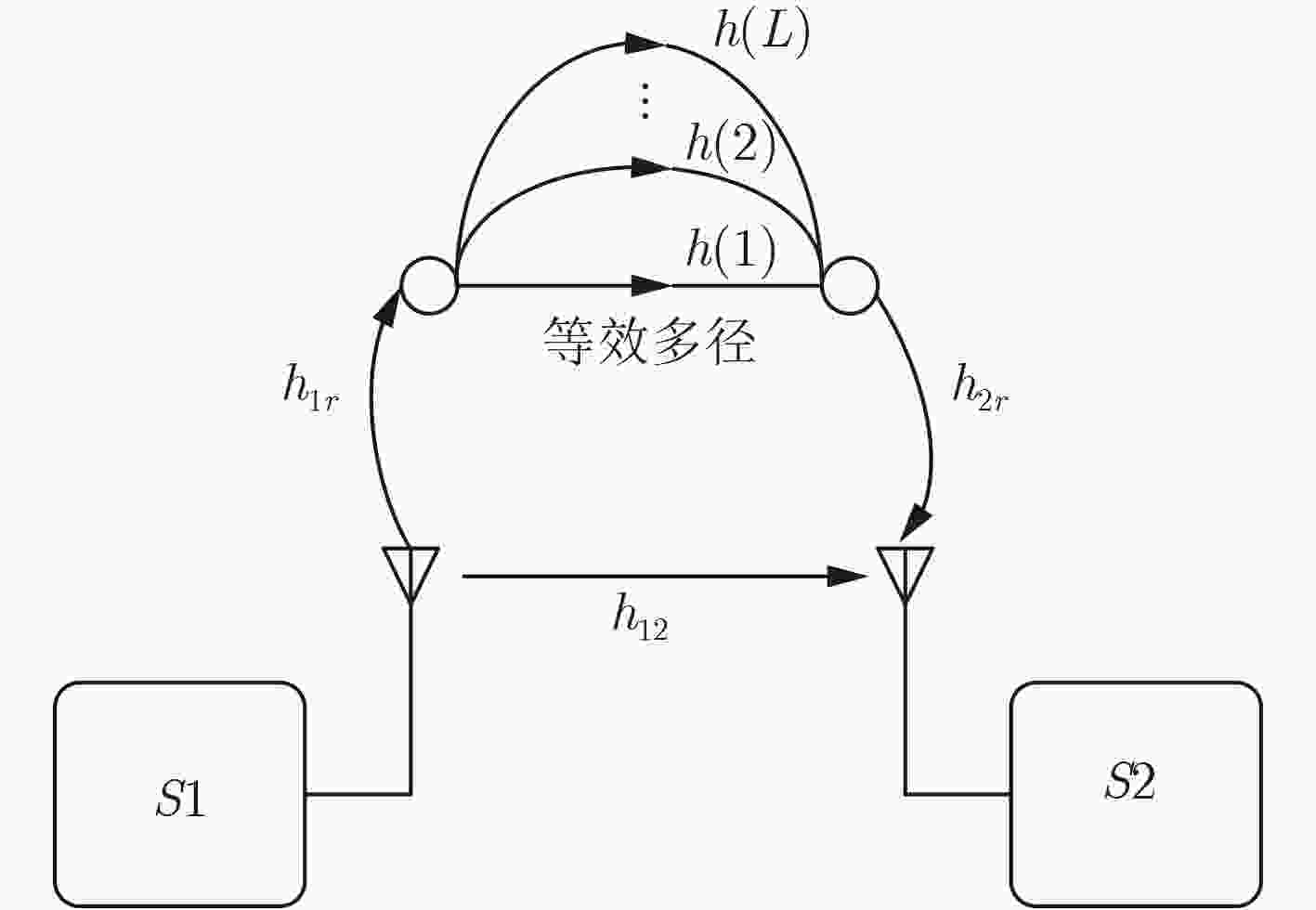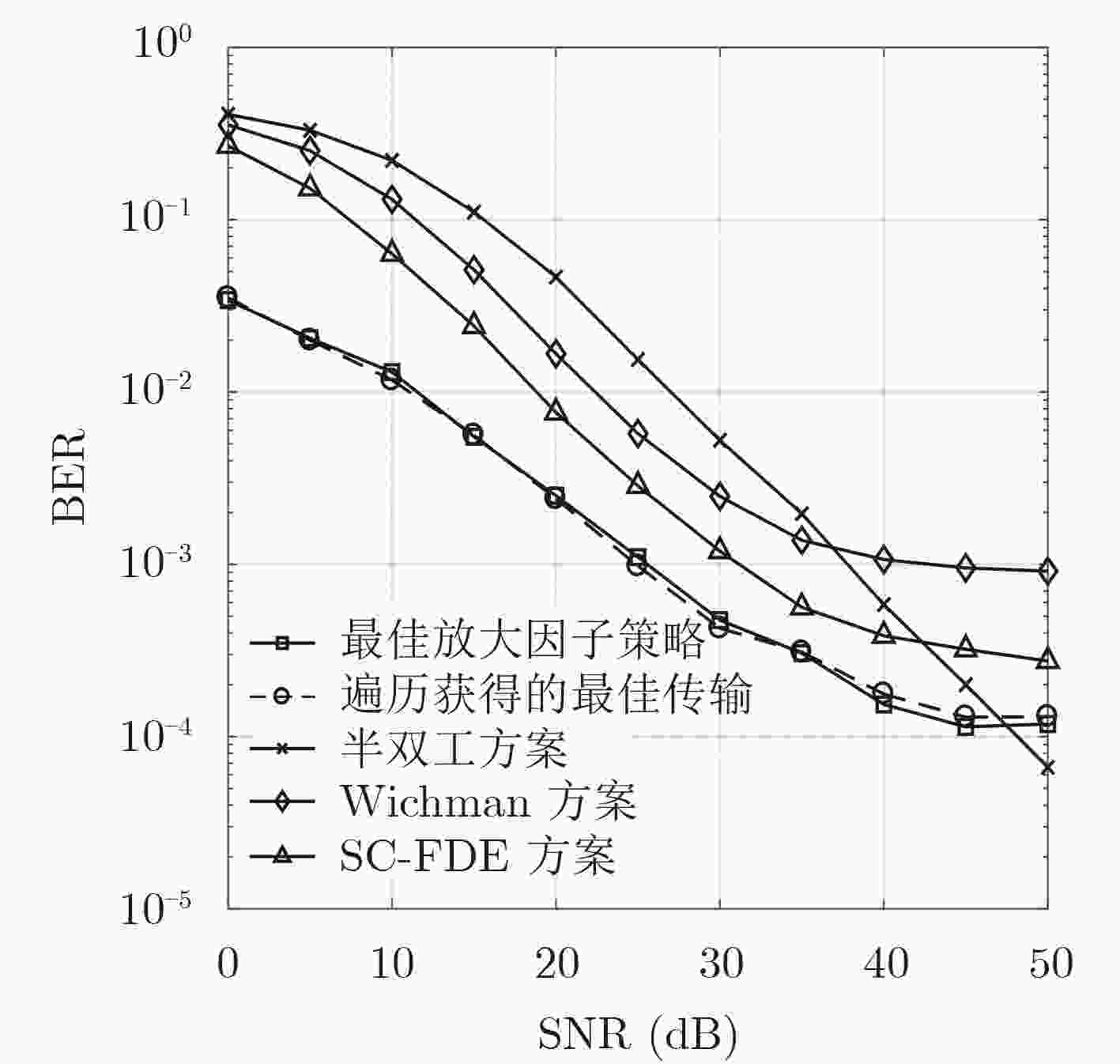High Spectrum Efficiency Full-duplex Two-way Relay Scheme for OFDM
-
摘要:
针对同时同频全双工双向中继网络,该文提出一种对中继剩余自干扰信号具有鲁棒性的双向中继传输方案。该文首先对中继剩余自干扰信号进行分析,将无限迭代的剩余自干扰信号建模成等效多径信号,并利用OFDM的循环前缀对抗等效多径现象,以降低中继剩余自干扰信号对系统传输性能的影响。在等效多径方案的基础上,以系统信干噪比最大化为目标,推导出全双工双向中继传输的最佳放大因子求解方法。最后,通过仿真验证所提出的双向中继传输方案的有效性。
Abstract:For the full-duplex two-way relay network, a two-way relay transmission scheme that is robust to the relay residual self-interference signal is proposed. Firstly, the residual self-interference signal of the relay is analyzed, the infinite self-interfering signal is modeled as an equivalent multipath signal, and the cyclic prefix of OFDM is used to combat the equivalent multipath phenomenon to reduce the residual self-interference signal impact. Based on the equivalent multipath scheme, the paper aims at maximizing the SINR of the system, and deduces the optimal amplification factor solving method of the relay in bidirectional full-duplex relay transmission. Finally, the simulation verifies the correctness of the optimal amplification factor of relay, and the effectiveness of the proposed two-way relay transmission scheme is verified through simulation.
-
Key words:
- Wireless communication /
- Full-duplex /
- Relay transmission /
- Equivalent multipath /
- Amplify and forward
-
表 1 信号x1(1)和x2(1)在各节点处的传输情况
时隙$i$ 0 1 ··· $i$ ··· ${r^{\left( 1 \right)}}(i)$ ${{h}_{1r}}{x_1}(1) + {{h}_{2r}}{x_2}(1)$ ${(\beta {{h}_{{\rm{li}}}})^1}({{h}_{1r}}{x_1}(1) + {{h}_{2r}}{x_2}(1))$ ··· ${(\beta {{h}_{{\rm{li}}}})^i}({{h}_{1r}}{x_1}(1) + {{h}_{2r}}{x_2}(1))$ ··· ${t^{\left( 1 \right)}}(i)$ 0 $\beta ({{h}_{1r}}{x_1}(1) + {{h}_{2r}}{x_2}(1))$ ··· ${(\beta {{h}_{{\rm{li}}}})^{i - 1}}\beta ({{h}_{1r}}{x_1}(1) + {{h}_{2r}}{x_2}(1))$ ··· $y_{1}^{\left( 1 \right)}(i)$ ${{h}_{{\rm{12}}}}{x_2}(1)$ $\beta {{h}_{1r}}{{h}_{2r}}{x_2}(1)$ ··· ${(\beta {{h}_{{\rm{li}}}})^{i - 1}}\beta {{h}_{1r}}{{h}_{2r}}{x_2}(1)$ ··· $y_{2}^{\left( 1 \right)}(i)$ ${{h}_{{\rm{12}}}}{x_1}(1)$ $\beta {{h}_{1r}}{{h}_{2r}}{x_1}(1)$ ··· ${(\beta {{h}_{{\rm{li}}}})^{i - 1}}\beta {{h}_{1r}}{{h}_{2r}}{x_1}(1)$ ··· -
SENDONARIS A, ERKIP E, and AAZHANG B. User cooperation diversity—Part I: System description[J]. IEEE Transactions on Communications, 2003, 51(11): 1927–1938. doi: 10.1109/TCOMM.2003.818096 SENDONARIS A, ERKIP E, and AAZHANG B. User cooperation diversity—Part II: Implementation aspects and performance analysis[J]. IEEE Transactions on Communications, 2003, 51(11): 1939–1948. doi: 10.1109/TCOMM.2003.819238 KUMAR N, SINGYA P K, and BHATIA V. Performance analysis of orthogonal frequency division multiplexing-based cooperative amplify-and-forward networks with non-linear power amplifier over independently but not necessarily identically distributed Nakagami-m fading channels[J]. IET Communications, 2017, 11(7): 1008–1020. doi: 10.1049/iet-com.2016.0797 NADERI S, JAVAN M R, and AREF A. Secrecy outage analysis of cooperative amplify and forward relaying in device to device communications[C]. 24th Iranian Conference on Electrical Engineering, Shiraz, Iran, 2016: 40–44. BOUTEGGUI M and MERAZKA F. Performance of source transmit antenna selection for MIMO cooperative communication system based DF protocol: Symbol error rate and diversity order[C]. International Conference on Wireless Networks and Mobile Communications (WINCOM), Rabat, Morocco, 2017: 1–8. SHARMA S, ROY S D, and KUNDU S. Two way secure communication with two half-duplex DF relay[C]. TENCON 2017: IEEE Region 10 Conference, Penang, Malaysia, 2017: 869–874. ATAPATTU S, HE Yuanyuan, DHARMAWANSA P, et al. Impact of residual self-interference and direct-link interference on full-duplex relays[C]. 2017 IEEE International Conference on Industrial and Information Systems (ICIIS), Peradeniya, SriLanka, 2017: 1–6. WATKINS G T, THOMPSON W, and HALLS D. Single antenna full duplex cancellation network for ISM band[C]. 2018 IEEE Radio and Wireless Symposium (RWS), Anaheim, USA, 2018: 21–24. DUARTE M and SABHARWAL A. Full-duplex wireless communications using off-the-shelf radios: Feasibility and first results[C]. the Forty Fourth Asilomar Conference on Signals, Systems and Computers, Pacific Grove, USA, 2010: 1558–1562. DUARTE M, DICK C, and SABHARWAL A. Experiment-driven characterization of full-duplex wireless systems[J]. IEEE Transactions on Wireless Communications, 2012, 11(12): 4296–4307. doi: 10.1109/TWC.2012.102612.111278 RIIHONEN T, WERNER S, and WICHMAN R. Mitigation of loopback self-interference in full-duplex MIMO relays[J]. IEEE Transactions on Signal Process, 2011, 59(12): 5983–5993. doi: 10.1109/TSP.2011.2164910 RIIHONEN T, WERNER S, and WICHMAN R. Optimized gain control for single-frequency relaying with loop interference[J]. IEEE Transactions on Wireless Communications, 2009, 8(6): 2801–2806. doi: 10.1109/TWC.2009.080542 LIU Yi, DAI Yue, and XIA Xianggen. SC-FDE based full-duplex relay communication robust to residual loop interference[J]. IEEE Wireless Communications Letters, 2017, 6(4): 538–541. doi: 10.1109/LWC.2017.2713381 JIN Yuansheng, XIA Xianggen, and CHEN Yan. Full-duplex delay diversity relay transmission using bit-interleaved coded OFDM[J]. IEEE Transactions on Communications, 2017, 65(8): 3250–3258. doi: 10.1109/TCOMM.2017.2704109 LIU Yi, XIA Xianggen, and ZHANG Hailin. Distributed space-time coding for full-duplex asynchronous cooperative communications[J]. IEEE Transactions on Wireless Communications, 2012, 11(7): 2680–2688. doi: 10.1109/TWC.2012.060212.112214 LIU Yi, XIA Xianggen, and ZHANG Hailin. Distributed linear convolutional space-time coding for two-relay full-duplex asynchronous cooperative networks[J]. IEEE Transactions on Wireless Communications, 2013, 12(12): 6406–6417. doi: 10.1109/TWC.2013.102313.130541 -






 下载:
下载:






 下载:
下载:
